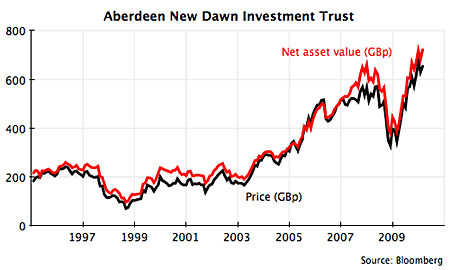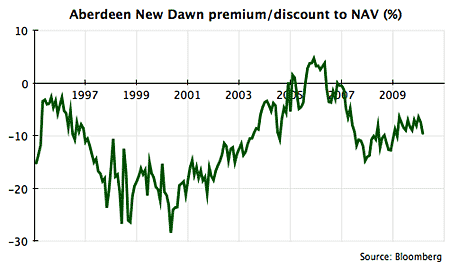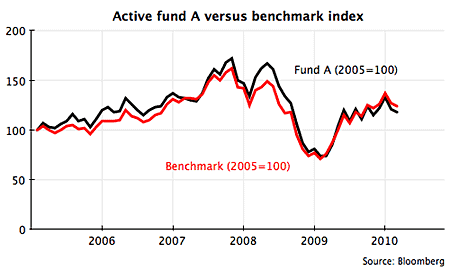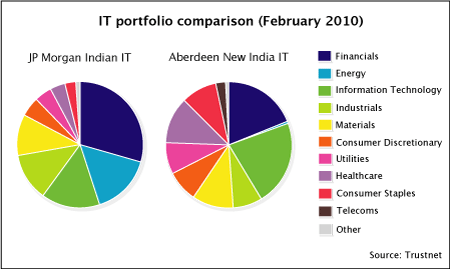Why investment trusts are a great way to buy into Asia
A particularly good way to invest in Asia is through funds. But you need to be careful about which fund - and which type of fund - to invest in. Here, Cris Sholto Heaton explains why he prefers closed-end investment trusts over other types of funds, and looks at how to select a promising one.

A while ago, I promised to compile a list of Asia-related investment trusts and closed-end funds. I've finally got a summary together, which you can download at the end of this article.
Before that, I'll look at why I favour investment trusts over other types of funds. And I'll look at how to select a promising fund. So if you just want the list, feel free to jump ahead.
What are investment trusts?
Most funds are 'open-end'. This means that the number of shares in the fund grow or shrink as people invest in or withdraw from it.
MoneyWeek
Subscribe to MoneyWeek today and get your first six magazine issues absolutely FREE

Sign up to Money Morning
Don't miss the latest investment and personal finances news, market analysis, plus money-saving tips with our free twice-daily newsletter
Don't miss the latest investment and personal finances news, market analysis, plus money-saving tips with our free twice-daily newsletter
An investment trust on the other hand is 'closed-end'. It has a fixed number of shares in issue, which are listed on the stock exchange. These are bought and sold through a stockbroker like any other shares.
What differences does this make for the investor? Firstly, when you invest in an open-end fund, it will be at a price directly tied to the fund's net asset value (NAV). With an investment trust, the shares trade independently of the NAV and can often be at a substantial discount or premium to it.
Many investors prefer the certainty of being able to buy and sell at the value of the assets. It's certainly more useful for a tracker fund. But if you can buy an out-of-favour investment trust at a discount, you may see that discount narrow as it comes back into favour.
The charts below show the price (black line), NAV (red line) and discount (green line in bottom chart) for the Aberdeen New Dawn IT, which in my view is a fairly good Asia ex-Japan fund. As you can see, during the sell-offs of the Asian crisis, the dotcom crash and the recent global panic, the discount expanded significantly.


But it narrowed during bull markets and even went to a premium in 2006-2007. This kind of behaviour makes closed-end funds an especially appealing way to invest after a crash.
Investment trusts tend to be cheaper
The second difference is the fee structure. Open-end funds typically charge an entry fee of up to 5% of your investment. Annual management charges vary, but range from around 0.5% for a tracker to around 3% for more specialist products. They also sometimes charge withdrawal fees of 2.5% or so.
With an investment trust, you'll have to pay stockbroker commissions. There's also a bid-offer spread on the trust's share price. That's the difference between the price at which you can sell (the bid price) and the price at which you can buy (the offer price). Annual management charges vary again but are typically around 1%-2%.
Obviously, which one works out cheaper will vary. But if you're using a low-cost broker that lets you trade for £10-£15 per trade and the bid-offer spread on the trust is fairly tight (1%-2% or so), there's a good chance that fees on an investment trust will be lower than the entry and exit charges on an open-end fund. Meanwhile, management charges are generally the same or lower. So all else being equal, a well-chosen investment trust is likely to cost you less in the long run.
There are a couple of other things that you should keep in mind with costs. It's not just the management fees that matter. You need to look at the total expense ratio (TER), which includes the fund's dealing and administration costs.
With a big fund managed by a big group, the difference might be relatively low less than 0.5 percentage points more than the management fee. But for small, independent funds, it can make a much bigger difference occasionally two percentage points or so.
Some funds also charge a performance fee. This is more common among more specialised funds, but more and more are trying to get away with it. I won't say that you should never pay performance fees, but it's rarely justified. When it is, there should be a hurdle rate (the minimum the fund must earn to get a performance fee) and a high water mark (meaning the fund must pass its highest-ever previous NAV, not just show an increase on last year).
Investment trusts are less likely to be closet trackers
There's another reason why I prefer investment trusts. That's because they can be better aligned with investors' interests.
The life of an investment manager is not a secure one. The main aim of a fund management company is not to make you money. It's to attract more new money into their funds and increase their assets under management, in order to earn more in fees.
So a manager who significantly underperforms their peers for a while and sees a lot of money leaving the fund runs a real risk of being fired. And unfortunately, taking the kind of contrarian decisions that make more sense in the long run will often lead to short-term underperformance. Think back to the dotcom era. It was just this that ended the careers of quite a few value-orientated managers who wouldn't buy into the bubble.
Expert tips & advice for investing in Asia! Claim your FREE guides from MoneyWeek that include:
- How to go about investing to Asia
- Which brokers to use to buy foreign shares
So managers have a big incentive to stick close to their peers and the market and try to avoid standing out to the downside. But if they do that, there's little chance of them standing out to the upside either. As a result, many actively managed funds end up effectively being trackers with higher fees.
The chart below shows a fairly typical open-end fund versus the benchmark for its market. It's an Asian country fund from a major fund group and charges a 5% entry fee and a 1.5% management fee.

I'm not naming the fund because I don't like singling out individuals and there may be circumstances that I don't know. But on this evidence, it's hard to see why you should be paying high fees for this performance rather than an annual TER of around 0.5% and a few pounds in brokers' commissions for an ETF that tracks this index.
Investment trusts get around this conflict by having permanent capital. No money can leave the fund. All that investors can do is sell the shares, which may then trade at a bigger discount. That can still create a lot of pressure, especially if activist investors buy up the shares and demand changes but it takes longer and gives managers a bit more protection. Consequently, investment trusts are less likely to end up as secret trackers.
So which investment trusts are best?
But not all investment trusts are good. You need to be as selective with them as any other fund. So what should you look for?
First, bear in mind that past performance is no indicator of future returns. Fund commentary tends to obsess over which managers have done best in the last few years. That's not remotely helpful. But a more detailed look at what the manager does can give you an idea of their approach and whether their past returns were chance or because of their style.
The first thing to look at is how the fund has performed relative to the benchmark index for the market it invests in. At this stage, I'm not concerned about whether it has underperformed or outperformed. What matters more to me is whether the fund has basically gone up and down pretty much in line with the index like the one above. Because if it has, I might as well buy a cheap tracker fund.
I want to see a manager try to do something different. The chart below shows the JP Morgan Indian IT (JII) and the Aberdeen New India IT (NII) versus the MSCI benchmark. Clearly one has done much better than the other in recent years but equally clearly neither is just tracking the index.

After that, I take a look at their portfolios. I'd check how many stocks the manager holds, what its biggest holdings are, and what sectors they're in. You can get this data from sites such as Trustnet, Morningstar and, for US closed-end funds, the Closed-End Fund Association. You usually need to use a combination of all these sites and you may also want to refer to the trust's annual report (available on the manager's website).
I like to see a manager running a concentrated portfolio of their best ideas. Of course, running a big fund can make this difficult you don't want to end up owning too much of a company's outstanding stock. But if I see a fund running 100 stocks or so, I usually ignore it. The more stocks it has, the closer it is to being a tracker. (I might make an exception for workaholic small-cap managers in the mould of Peter Lynch.)
Both funds do well here. NII holds a tightly-focused 25 stocks, while JII has 44 (still low by industry standards).
Then I'd look at the portfolio in more detail and think about what the strategy is. Here, NII looks more distinctive. JII's portfolio doesn't stray too far from the benchmark weightings and most of its largest holdings are the largest stocks in the Indian market.
But NII seems to be significantly biased towards sectors such as healthcare and consumer goods and away from industrials, which are the areas that I'm especially interested in for the long-term. And there are some notable omissions from its top holdings, most obviously Reliance Industries, the largest firm in the index. Given the ongoing family feud in this group, I think this is a bold and wise decision.

NII lagged behind during the last few years because the boom favoured cyclical stocks (unsurprisingly its more stable portfolio did better during the downturn). However, on a very long-term view, I'd favour this fund over JII for an India portfolio. It's not that I think JII is a bad fund, but the Aberdeen management team's strategy seems more in line with my own thinking.
A comprehensive list of Asia-related closed-end funds
You can download my list of Asia-related closed-end funds (and also the latest version of my ETF spreadsheet). Of course, there are a huge number of companies whose purpose is investment, so as a cut-off here I've focused on those that mainly invest in a diversified portfolio of listed assets.
That means I'm not including specialist property and infrastructure funds, though I'll think about doing a list of them in future. And I'm sure I've missed some, so please let me know if there are any you think should be on the list.
I don't have space to go over all of them here, but here are just a few ideas that strike me as interesting. I'm generally impressed with the Aberdeen team and like most of their funds. In addition, for those of you looking to drip-feed money into trusts, Aberdeen offers an investment plan for their UK trusts with no purchase fees, a £100 monthly minimum and an ISA wrapper as far as I know, it's the only investment trust manager to do this.
The US-listed China Fund, run by Martin Currie, has a much higher consumer weighting than most China funds. Aberdeen has the only Asian bond closed-end fund, listed in the US. Baillie Gifford has a couple of interesting small cap Japanese funds. And the Vietnam Opportunity Fund is on a discount of 40% to NAV, which compensates for it charging a performance fee, if you're interested in this promising but highly volatile frontier market.
This article is from MoneyWeek Asia, a FREE weekly email of investment ideas and news every Monday from MoneyWeek magazine, covering the world's fastest-developing and most exciting region. Sign up to MoneyWeek Asia here
Get the latest financial news, insights and expert analysis from our award-winning MoneyWeek team, to help you understand what really matters when it comes to your finances.
Cris Sholto Heaton is an investment analyst and writer who has been contributing to MoneyWeek since 2006 and was managing editor of the magazine between 2016 and 2018. He is especially interested in international investing, believing many investors still focus too much on their home markets and that it pays to take advantage of all the opportunities the world offers. He often writes about Asian equities, international income and global asset allocation.
Cris began his career in financial services consultancy at PwC and Lane Clark & Peacock, before an abrupt change of direction into oil, gas and energy at Petroleum Economist and Platts and subsequently into investment research and writing. In addition to his articles for MoneyWeek, he also works with a number of asset managers, consultancies and financial information providers.
He holds the Chartered Financial Analyst designation and the Investment Management Certificate, as well as degrees in finance and mathematics. He has also studied acting, film-making and photography, and strongly suspects that an awareness of what makes a compelling story is just as important for understanding markets as any amount of qualifications.
-
 Why pension transfers are so tricky
Why pension transfers are so trickyInvestors could lose out when they do a pension transfer, as the process is fraught with risk and requires advice, says David Prosser
-
 The political economy of Clarkson’s Farm
The political economy of Clarkson’s FarmOpinion Clarkson’s Farm is an amusing TV show that proves to be an insightful portrayal of political and economic life, says Stuart Watkins
